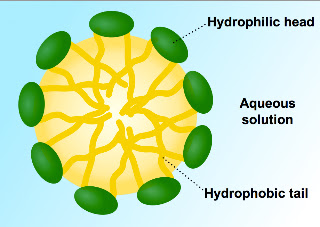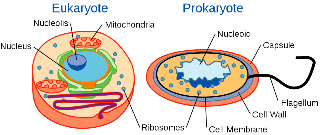 |
| Phospholipids: their shape makes organismic life possible. |
Our goals in doing this are:
a) to replace the self-contradictory and rigid categories underlying the foundations of biology with measurable qualities, that is, to shift from a rational but arbitrary understanding of the world to an empirical one;
 |
| Micelles: Phospholipids in water form spheres. |
c) to give us a context for discussing complex, adaptive systems like VISTA, which until now have had to hobble along without a coherent vocabulary or conceptual framework.
In The Nature of Order, Volume 1: The Phenomenon of Life, Christopher Alexander posits a new definition of life based on his decades-long search for an unambiguous way to distinguish living architecture from nonliving. Because a work of architecture is so different from an organism, so much less complex (at least, until you add in its relationships with people, that is), the natural factors of such an architecturally oriented definition will drive us far away from our organismic prejudices, which is exactly what we want in a more fundamental definition of life.
 |
| Vesicles: micelles with water inside and outside. |
Instead of defining life in terms of organismic living processes, Alexander defines it in terms of geometry. This would seem natural for an architecturally based definition of life, given the importance of geometry to architecture, but it also turns out to be a natural foundation for a complete definition of biological life.
 |
| Cell membranes: complex vesicles with proteins. |
From every perspective, at every scale, proper geometry turns out to be a prerequisite for life. Life depends upon its geometry. Disrupt a lifeform's geometry and you damage or kill it. Assemble the geometry of life, and life self-organizes in seeming defiance of the laws of entropy.
 |
| Cells: the geometry of inside & outside creates organisms. |
In his definition of living geometry, Christopher Alexander cites fifteen interrelated geometric properties:
1) levels of scale,
2) strong centers,
3) boundaries,
4) alternating repetition,
5) positive space,
6) good shape,
7) local symmetries,
8) deep interlock and ambiguity,
9) contrast,
10) gradients,
11) roughness,
12) echoes,
13) the void,
14) simplicity and inner calm, and
15) not-separateness
In the posts ahead, we will define and explore these fifteen properties and show how they are as essential to living organisms and other living systems as they are to living architecture.
PHOTO CREDITS
1) A phospholipid (http://en.wikipedia.org/wiki/Phospholipid), like the nutrient lecithin (aka phosphatidylcholine), is an organic molecule with the shape of a tuning fork, in which its tails are repelled by water, but its head is attracted to it. Just like a magnet's geometry is aligned by its magnetic properties toward magnetic north and south (or toward other magnets), a phospholipid's geometry is aligned by its chemistry toward and away from water. Although much less complex and exciting than DNA, phospholipids are every bit as essential to the creation of cells, since their chemical orientation toward and away from water create the geometry of cells - the inside and outside.
Photo: Space-filling models of sphingomyelin (a) and cholesterol (b). This figure shows the inverted cone-like shape of a common sphingolipid (sphingomyelin) and the cone-like shape of cholesterol based on the area of space occupied by the hydrophobic and hydrophilic regions. Diagram created on 26 April 2009 by Wikipedia user Wlstutts.
Source: Wikipedia (http://commons.wikimedia.org/wiki/File:Space-Filling_Model_Sphingomyelin_and_Cholesterol.jpg)
2) Micelles (http://en.wikipedia.org/wiki/Micelle) are the geometric solution to a geometric/chemical problem: dump a bunch of phospholipids in water, and the molecules will have to find a way to hide their water-hating tails. The solution is to form balls of phospholipids in which the water-loving heads face out toward the water and the water-hating tails face inward together away from the water. That is, the phospholipids align themselves into balls to mutually protect their tails. The tails are repelled by water because are made of fatty acid chains, so like oil they won't mix with water. As a result, a micelle can't store water, since that would repel all the tails inside the micelle; they can only keep water out.
Photo: Scheme of a micelle formed by phospholipids in an aqueous solution. Diagram created using Inkscape on 12 October 2007 by Wikipedia user SuperManu.
Source: Wikipedia (http://en.wikipedia.org/wiki/File:Micelle_scheme-en.svg)
3) Vesicles (http://en.wikipedia.org/wiki/Vesicle_(biology_and_chemistry)) are how phospholipids solve the problem of storing water as well as keeping water out. In addition to forming into solid balls (micelles), phospholipids can also form into hollow balls that can contain water. They do this by creating a second layer of phospholipds; the water-hating tails of each layer of phospholipids point toward each other to keep away from the water inside and outside. This clever geometric structure creates the next level of biological structure, in which we not only have water outside, we also have water inside - and most importantly, the two liquids can be different, since they are insulated from each other. This is the geometric precondition for all cellular life, which must be able to carry its necessary fluid conditions for life around inside itself. It can only do that by building upon the vesicle shape that phospholipids automatically generate in the presence of water because of their own geometry.
Photo: Scheme of a liposome formed by phospholipids in an aqueous solution. Diagram created using Inkscape on 15 October 2007 by Wikipedia user Supermanu.
Source: Wikipedia (http://en.wikipedia.org/wiki/File:Liposome_scheme-en.svg)
4) Cell Membranes (http://en.wikipedia.org/wiki/Cell_membrane) are vesicles with additional structure. The double-phospholipid layer of the vesicle is augmented with proteins, whose different shapes allow them to carry out different biochemical work, such as opening and closing holes in the membrane to allow selected molecules (like sugar or oxygen) to pass through the membrane, or providing anchor points for a cell's internal skeletons to attach to, or detecting specific substances outside the cell so the cell can react to them. But when we ignore all the added complexity, the underlying structure of all cell membranes is still the vesicle's structure, so much so that when the cell wants to bring in materials from outside, the membrane folds around it and pinches off to create a new vesicle that contains the substance, a process called pinocytosis (http://en.wikipedia.org/wiki/Pinocytosis). Cells are full of vesicles that store materials for the cell's use, and these vesicles are continually budding off the membrane or reuniting with it. Cell membranes are what happen when phospholipids and proteins join forces to protect their geometry.
Photo: The cell membrane, also called the plasma membrane or plasmalemma, is a semipermeable lipid bilayer common to all living cells. It contains a variety of biological molecules, primarily proteins and lipids, which are involved in a vast array of cellular processes. It also serves as the attachment point for both the intracellular cytoskeleton and, if present, the cell wall. This diagram was derived from 13 to 16 June 2008 by Wikipedia user Dhatfield from originals created from 31 January to 24 August 2007 by Wikipedia user LadyofHats.
Source: Wikipedia (http://en.wikipedia.org/wiki/File:Cell_membrane_detailed_diagram_4.svg)
5) Cells (http://en.wikipedia.org/wiki/Cell_(biology)) may be controlled by the way their DNA defines their proteins and RNA, and in turn by the way those molecules manage the cell's life processes, but cells are structured by their many membranes. Vesicles, plastids, the endoplasmic reticulum, the Golgi apparatus, mitochondria, vacuoles, the nucleus, lysosomes, and many, many other kinds of organelles within cells are made up of these kinds of phospholipid membranes. The geometry of the phospholipid is thus the basic building block of the geometry of the cell, making it possible to separate the organism from its environment, and to separate all its internal resources and functions. Without that ability to control the separation and recombination of resources and functions, they would mix chaotically according to the laws of entropy, and the cell would be impossible.
In our era we focus on DNA as the building block of life, but DNA is so complex that it is fragile and easily damaged; unless it can be very well insulated from the surrounding environment and from most of the cell's own operations, DNA too quickly breaks down. Phospholipids and the layers, balls, spheres, and membranes they naturally self-organize into create the geometry that makes stable DNA possible, along with all the other preconditions for cellular life.
Photo: The cells of eukaryotes (left) and prokaryotes (right). This image is from the Science Primer (http://www.ncbi.nlm.nih.gov/About/primer) a work of the National Center for Biotechnology Information (http://en.wikipedia.org/wiki/National_Center_for_Biotechnology_Information), part of the National Institutes of Health (http://en.wikipedia.org/wiki/National_Institutes_of_Health). This version of the Science Primer was revised 30 March 2004. The image itself was vectorized using Inkscape on 23 May 2007 by Wikipedia user Mortadelo2005.
Source: Wikipedia (http://en.wikipedia.org/wiki/File:Celltypes.svg)



3 comments:
INSTANTLY ANALYZE YOUR SEO ISSUES..
Helps To Identify Your SEO Mistakes And Better Optimize Your Site Content.
Free SEO team
Choose theme of your website and get developed very cheap.
Web Developer
Get listed your business in our website. We can publish your website in our 5 blogsite. Also we will provide you article marketing services.
Article hotspot
Post a Comment